Generate Email Templates for Inbound Sales That Convert
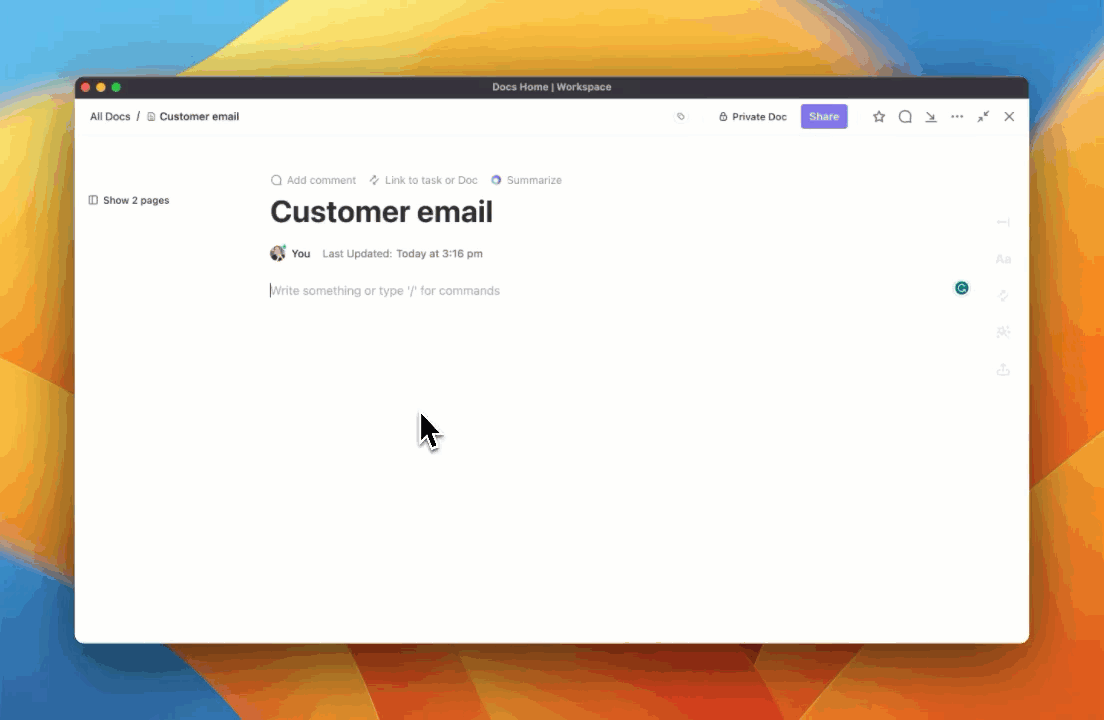
Sorry, there were no results found for “”
Sorry, there were no results found for “”
Sorry, there were no results found for “”

Sales representatives spend nearly a fifth of their day writing emails, including cold emails. Yet, for all that effort, the results aren’t always what they hope for.
That’s because inbound sales is more than just hitting reply to a prospect’s questions. It involves qualifying leads, addressing a specific challenge, and building meaningful conversations. To stay focused on these high-impact tasks, reps need to reclaim their time.
The sales process will always include email marketing, but the workflow doesn’t have to be initiated from the beginning each time. That’s where automation comes in, making life easier for sales professionals.
Generating email templates for inbound sales provides your team with a personalized, efficient, and ready-to-use framework for every stage of the sales cycle.
In this article, we’ll explore how to use AI to generate inbound sales templates that save time and improve response rates.
If you’re starting to curate content for your inbound funnel, the Drip Campaign Template by ClickUp is a great starting point to build automated, multi-stage email sequences that nurture leads and deliver personalized content.
Buyers don’t believe anything you have to say to them about your product or service until they first believe in you.
That’s what author Deb Calvert once said, and it rings especially true in inbound sales.
With inbound leads, you’ve already completed the most challenging step. Your potential customers have clicked, subscribed, downloaded, or signed up. They’ve already seen the value you can provide to them. It is now your responsibility to enhance that interest with a message that references any mutual connection at the right time.
Inbound sales email templates focus on trust, timing, and relevance, unlike cold email templates that aim to break the ice with strangers.
However, this means your overall strategy, from subject line to call to action, matters more.
Here’s how compelling inbound sales emails and effective email outreach stand apart:
📖 Also Read: How to Use AI to Write Emails
Inbound sales emails are different by nature, so your approach to writing them should be different, too.
It’s about delivering the right message that builds trust and moves them closer to becoming a paying customer.
Here are the most important elements to include in your inbound lead email templates:
Inbound emails work best when they are grounded in context. You are not emailing a stranger; you are continuing a conversation.
Take the time to understand what triggered the contact. Was it a webinar registration? A pricing page visit? A blog post download?
📌 Example: Let’s say a small business owner downloads your pricing guide. A generic sales email would waste that opportunity. Instead, try:
“Hi Alex, thanks for downloading our pricing overview. If you are exploring [type of tool] tools for your 5-person team, I’d love to share how other small businesses are using [Company Name] to streamline client onboarding.”
👀 Fun Fact: Ray Tomlinson, the engineer who sent the world’s first email in 1971, also chose the “@” symbol to separate user and host names—a design choice later recognized by the Museum of Modern Art as part of its permanent collection.
Subject lines are your first impression. Your subject line must get clicked, or your message won’t matter, even if it’s perfect.
Good inbound subject lines balance relevance and curiosity. They acknowledge the prospect’s recent interaction while providing valuable information.
📌 Example: “Here’s the info you requested after the webinar”
📖 Also Read: Effective Email Campaign Management Strategies
Your email should have one purpose. Not three. Not two. Whether it’s booking a demo request, claiming a free trial, or starting a brief call, make it clear, make it simple, and make it actionable.
📌 Example: If someone just explored your product features page, a strong inbound email might say:
“Based on your interest in the Pro plan, would you be open to a 15-minute personalized demo this week?”
[Book Your Demo]
That is it. No multiple links or distractions. Just one clear call to action.
📮 ClickUp Insight: 37% of respondents say they use AI for writing, editing, and content creation. But for most, this still means jumping between different tools to get work done. With ClickUp, AI writing support is built right into your workspace—whether you’re drafting emails, replying to comments, chatting with teammates, or writing Docs. Everything stays connected and context-aware.
Inbound sales emails are about momentum. A long-winded message can slow that down. Respect the reader’s time by getting to the point, addressing a specific pain point, and offering a next step.
📌 Example: “I saw you downloaded our ‘Top 10 Client Retention Tactics’ guide last week. If you are focusing on improving customer loyalty, I’d love to share some valuable insights and a few quick wins we have seen with other agencies like yours.”
The best sales email templates offer helpful suggestions without overexplaining. They assist potential customers in quickly making connections.
📖 Also Read: Best Email Outreach Tools
When a prospect signs up for your blog or attends a webinar, they are looking to learn, not buy immediately. Use this opportunity to deliver free value and deepen the personal connection.
📌 Example: Send a welcome email template that includes your best blog posts, relevant case studies, and an invite for a free consultation. End with:
“Let me know if you would like a personalized follow-up email with a few hand-picked resources for your team.”
📖 Also Read: How to Create Sales Enablement Content
Every salesperson and copywriter knows that personalized leads result in higher open rates.
The more specific and timely your message, the more likely it is to spark a response.
And here’s the positive news: you do not have to write every follow-up email template or sales email from scratch.
43% of marketers using generative AI say it’s most helpful for creating emails that highlight key benefits.
Tools like ClickUp Brain make the process easier and more effective. Unlike standalone AI generators, ClickUp Brain is your Contextual AI assistant that lives inside your existing ClickUp Workspace and draws its knowledge from your ongoing projects, deals, and leads. It also connects with Google Workspace tools like Drive, Gmail, and Docs, allowing you to generate inbound email templates based on real files, campaign notes, and previous email threads.
This means your sales team is not working off isolated data points. The copy you generate is tied to your contact details, deal stages, and campaign activity, and feels like it’s written by someone who truly understands the prospect’s pain point.
Curious where else AI can prove useful in sales? Watch this video to learn more:
👀 Fun Fact: The term “Inbox Zero” was coined in 2006 by productivity expert Merlin Mann. It wasn’t about having an empty inbox at all times, but rather about reducing the mental weight of unread messages. His philosophy sparked a whole generation of email productivity tools, templates, and debates that still continue today.
Writing inbound sales emails with ClickUp AI
One of the biggest challenges in inbound sales is responding fast without sounding robotic. ClickUp Brain solves that by giving your sales team instant access to high-quality, personalized email templates.
Here are three real-world scenarios with sample ClickUp Brain prompts you can use to create high-converting inbound sales email templates in seconds.
ClickUp Brain prompt:
“Generate an inbound follow-up email template for a lead who attended our webinar on streamlining client onboarding. Include a clear call to action for a personalized demo and highlight one specific benefit of our platform.”
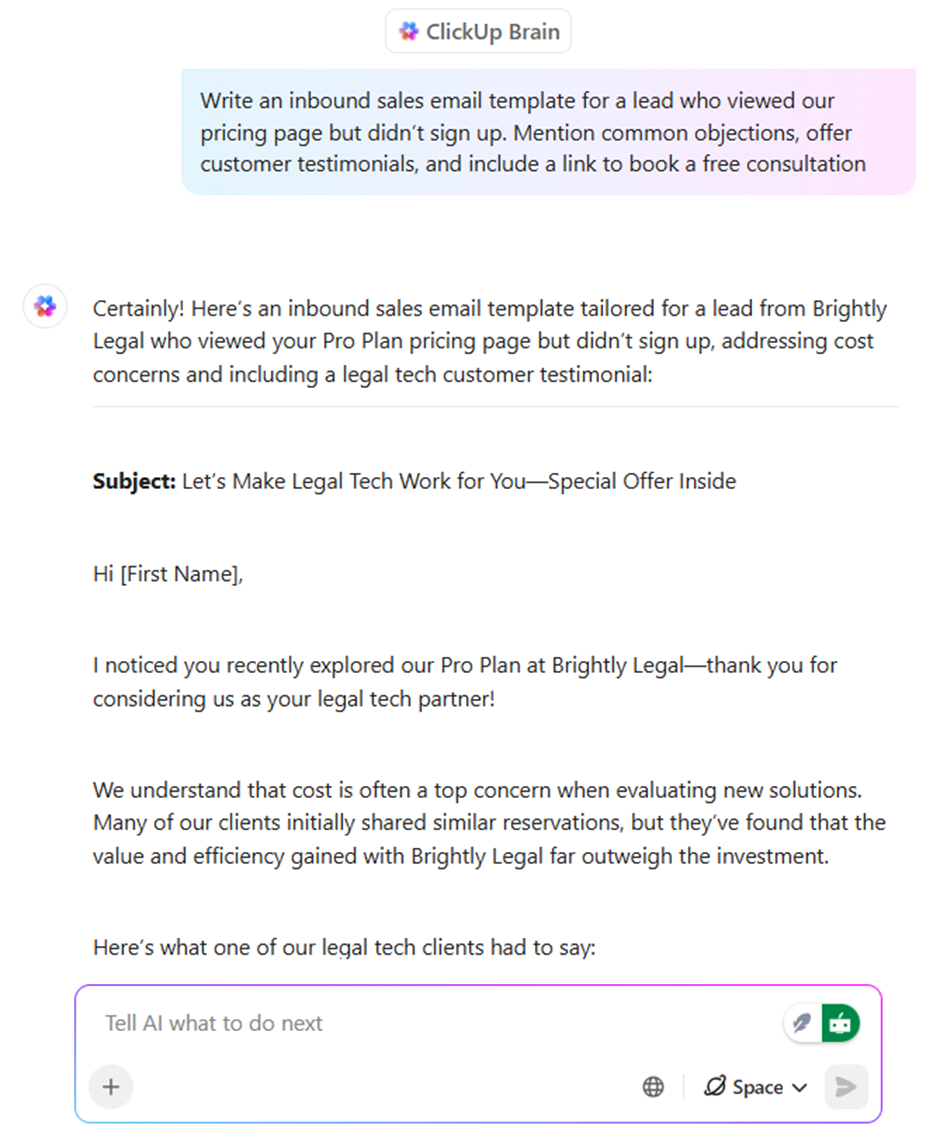
ClickUp Brain prompt:
“Write an inbound sales email template for a lead who viewed our pricing page but didn’t sign up. Mention common objections, offer customer testimonials, and include a link to book a free consultation.”
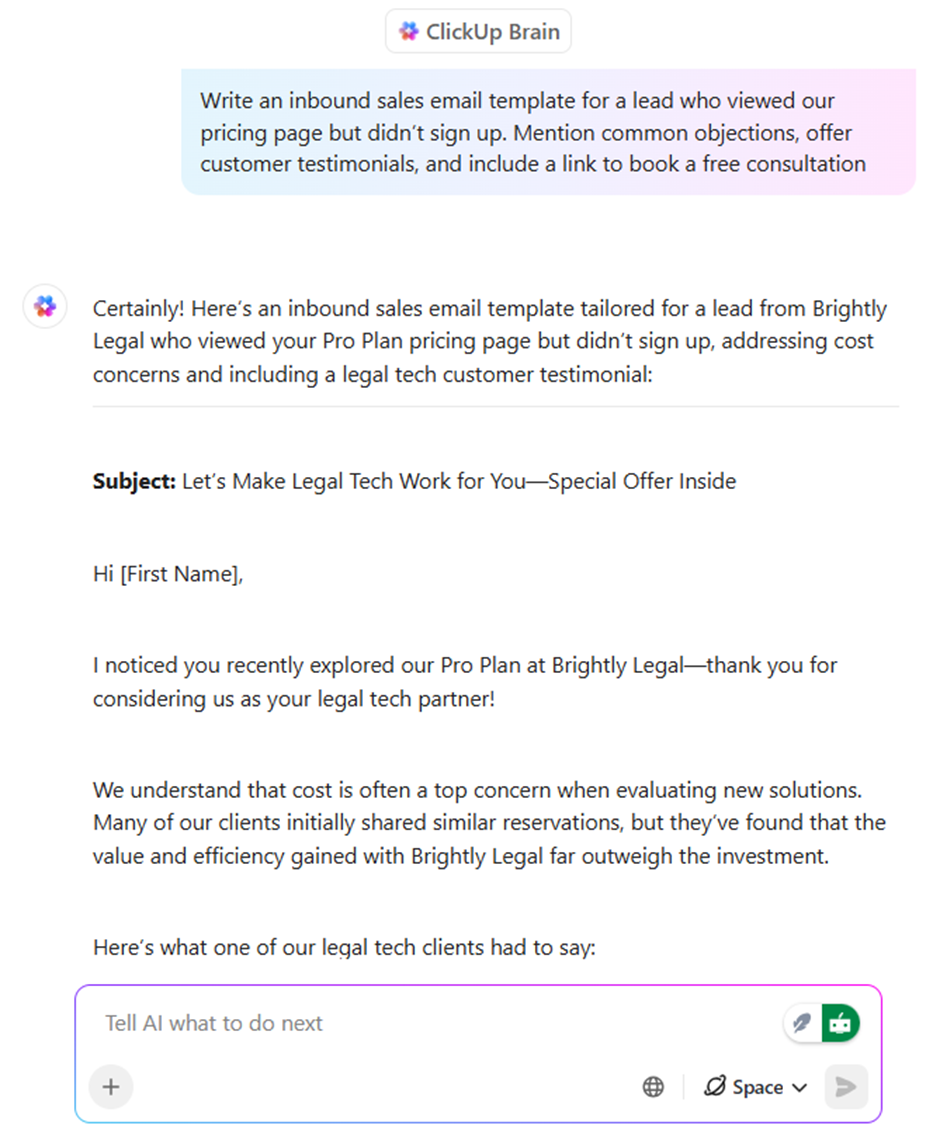
📖 Also Read: Free Sales Plan Templates in Word, Excel, & ClickUp
ClickUp Brain prompt:
“Create a re-engagement email template for an inbound lead who downloaded our whitepaper 3 weeks ago but hasn’t responded since. Offer free value and suggest a quick call to explore fit.”
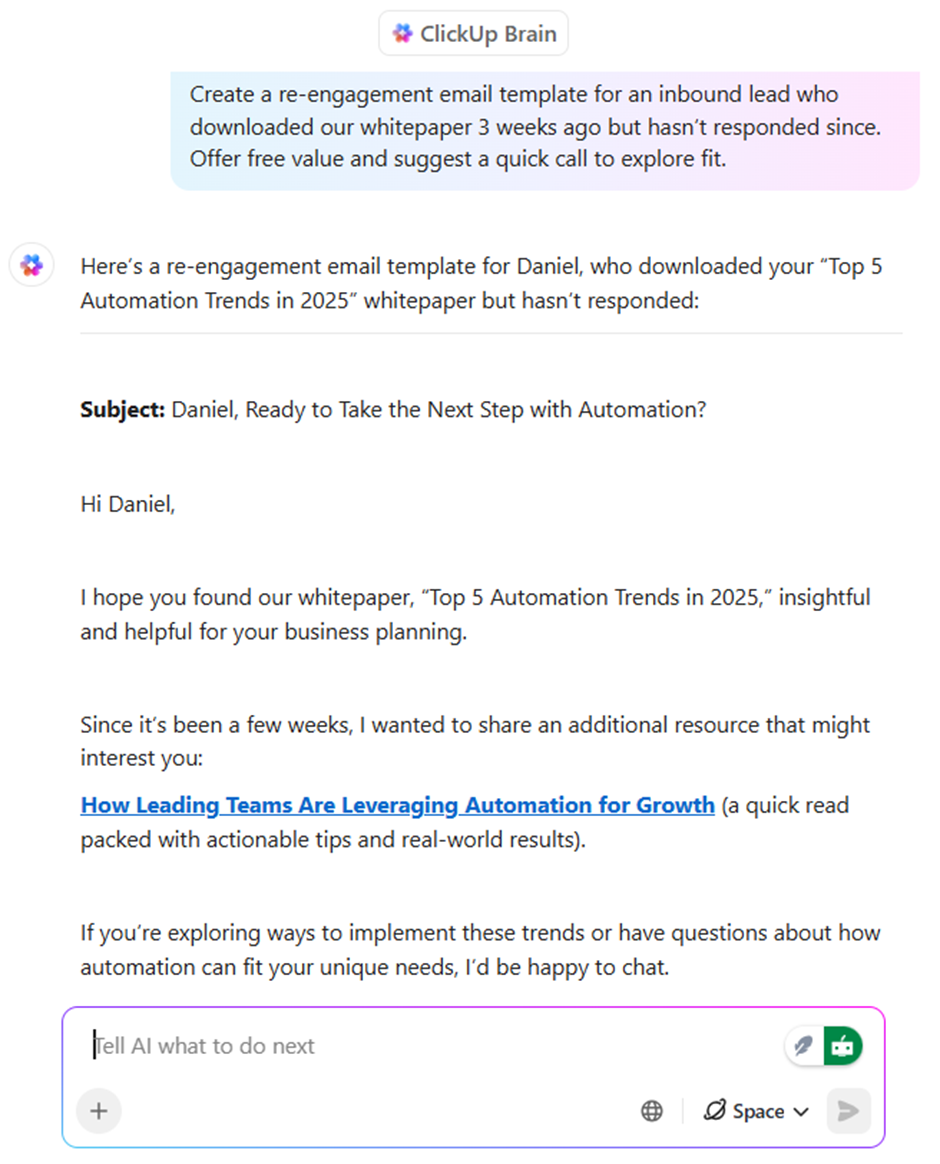
Here’s a very simple video on how to get started with writing using ClickUp Brain in seconds:
Once you’re done generating your inbound sales templates for your company name, you need a central place to organize and refine them.
This is where ClickUp Docs come in.
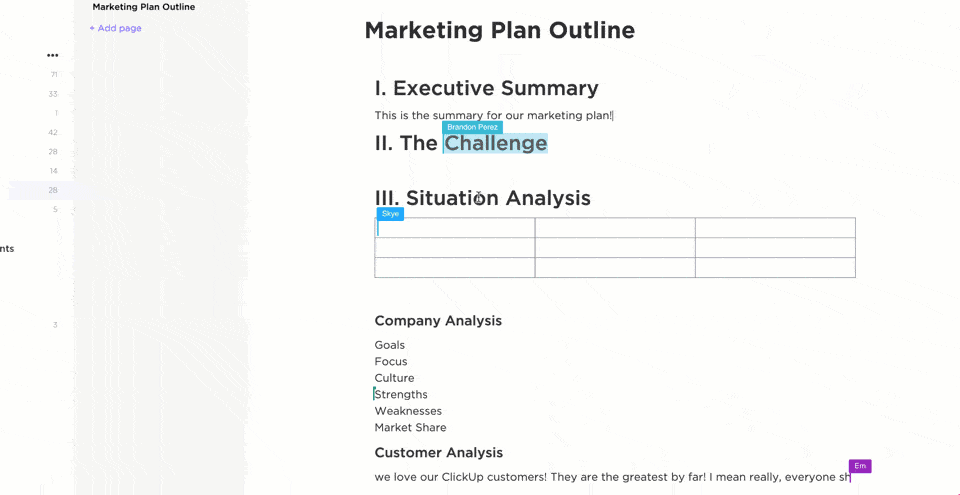
You can store all your email templates in one Doc, collaborate with your team in real time, and turn feedback comments into tasks instantly. It keeps your entire inbound sales process structured, accessible, and tied directly to your workflows.
Once your templates are ready and stored in ClickUp Docs, the next step is to plug them into your broader sales process. That’s where ClickUp’s 1000+ built-in templates for campaigns and email automation come in handy.
A fantastic place to start is the Drip Campaign Template by ClickUp, especially if you’re planning to nurture inbound leads over time. This template helps you structure email sequences across the funnel, monitor engagement, and optimize outreach efforts without building campaigns from scratch.
Another useful option is the Email Automation with ClickUp Template, which lets your sales team visualize the entire automation workflow. This sales email template helps assign tasks, manage timing, and ensure each follow-up email template or sales email gets delivered to the right person at the right time.
📖 Also Read: Free Onboarding Email Templates
Writing great inbound sales email templates is just the beginning. ClickUp gives you a few extra tools to help your team handle email project management flawlessly and fully in sync, especially when those leads start coming in!
Q: Can I standardize lead follow-ups without rewriting the same message each time?
Yes, you can create task templates for lead follow-up with pre-filled email copy, email marketing checklists, and reminders. When a new lead comes in, ClickUp automatically creates a task using your saved template. All your sales rep needs to do is tweak the message and hit send. This keeps outreach consistent and saves time with every new inbound lead.
📖 Also Read: Best Sales Onboarding and Training Software
Q: What if marketing updates the messaging mid-funnel?
That’s where real-time collaboration with marketing comes in. Shared Docs and ClickUp Assign Comments let both teams align instantly when messaging, offering, or product language changes. If marketing updates positioning, sales will see it reflected in shared templates or funnel-stage tasks.
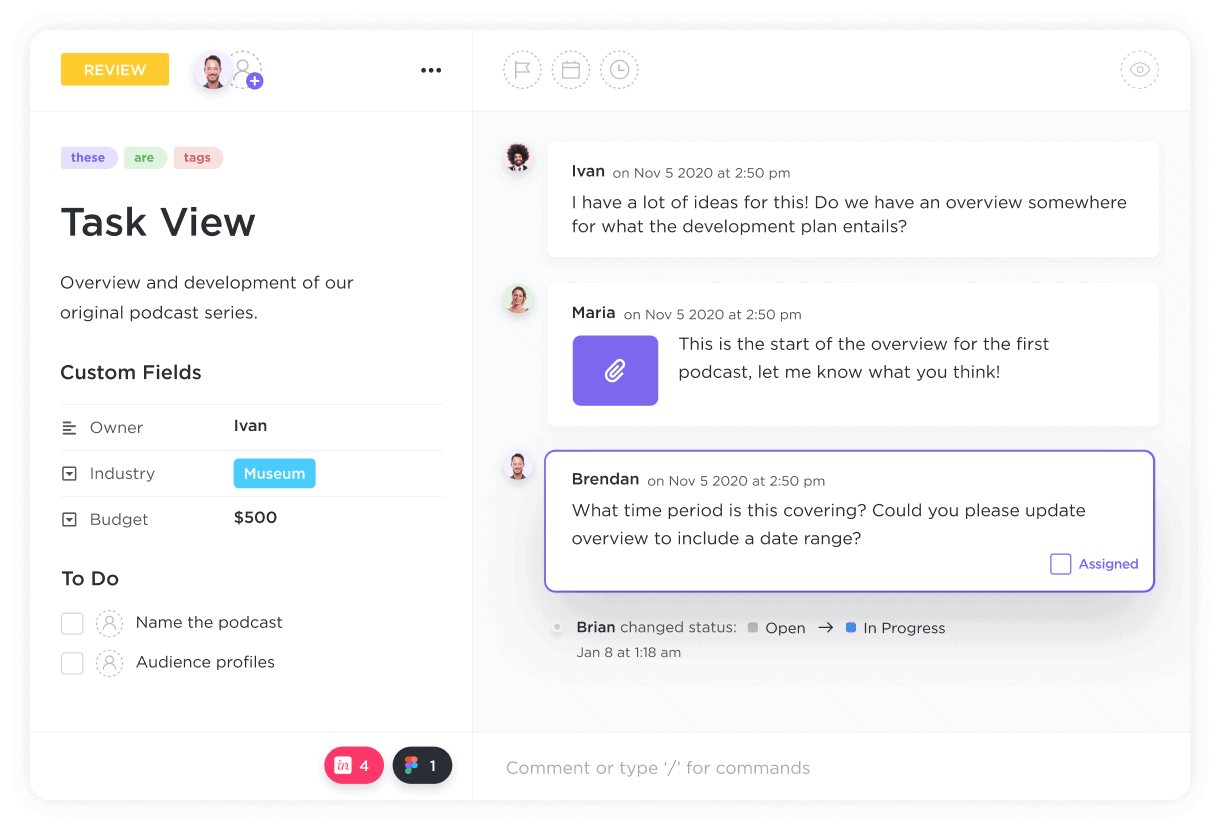
📖 Also Read: Best AI Tools for Sales Teams
Q: How do I know which inbound email templates are working?
With ClickUp Dashboards, you can track performance metrics like open rates, replies, and conversion timelines across sequences. Sales managers can quickly spot which templates or sequences are generating traction and where drop-offs happen, making it easier to improve and scale what’s working.

Q: Can I assign follow-ups automatically based on lead interest?
Absolutely. ClickUp Automations let you route follow-up tasks based on the form type or lead source. If someone requests a demo, it creates a high-priority task with a checklist and deadline for the sales rep. For newsletter signups or low-intent forms, a separate nurturing task can be triggered. No manual sorting, no missed leads.
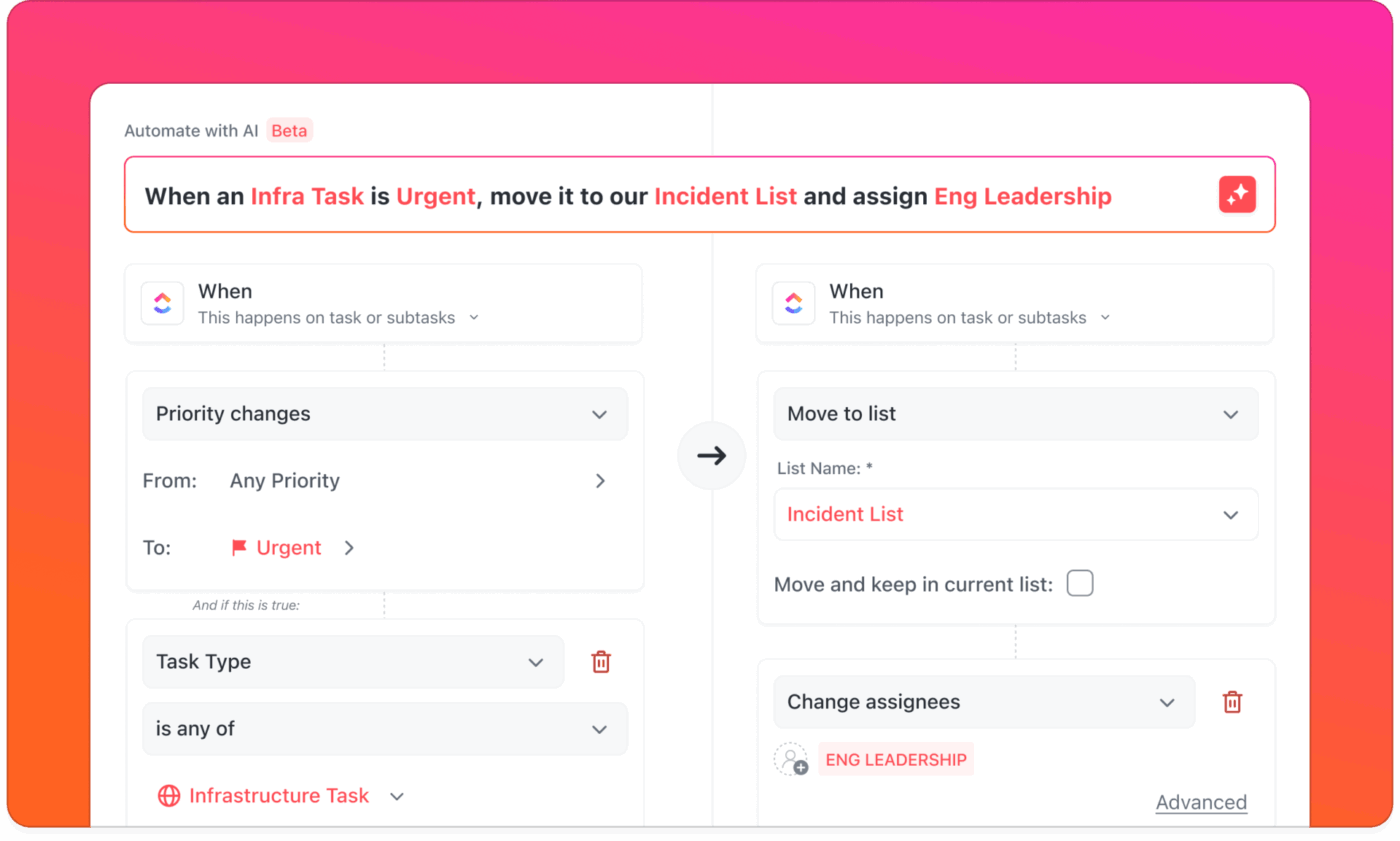
👀 Fun Fact: Gmail launched on April Fools’ Day. When Google announced Gmail in 2004, many people believed it was a prank. Offering 1 GB of storage sounded unbelievable compared to the 2 MB inboxes people were used to.
You can have the right email management software and templates, but where things can go wrong is a thoughtful sequence strategy.
To turn inbound leads into real conversations and conversions, especially with new customers, your email sequences need to feel timely, personal, and purpose-driven. Here are some tips:
✅ Start with a clear objective for every sequence. Whether it’s booking a demo, nurturing a lead, or re-engaging a quiet prospect, your call to action should reflect that goal
✅ Map your sequence to your sales cycle by sending emails at a pace your audience can keep up with. Avoid overwhelming your leads with daily messages unless the timing calls for urgency
✅ Keep your subject lines tight and curiosity-driven, but always rooted in context so the reader knows exactly why they are hearing from you
✅ Write emails that feel helpful, not pushy. Educate with case studies, solve problems with how-to content, and build trust before you ask for time or action
✅ Track performance metrics like reply rates, CTA clicks, and time to conversion. Use those insights to refine your email templates and improve what matters most
📖 Also Read: How To Use AI In Sales
When it comes to inbound leads, the window to respond is small. Your team shouldn’t waste time rewriting the same email for the hundredth time.
ClickUp helps you stay sharp and quick. With AI-generated templates, built-in automations, and Docs that actually connect to your tasks, your inbound email process becomes part of your sales workflow, not separate from it.
Everything lives in one place. Nothing gets missed. And every follow-up feels intentional.
Want to close the loop on better inbound emails? Sign up on ClickUp today!
Inbound emails are sent to leads who have already shown interest, like signing up for a webinar or downloading a guide. Outbound emails go to cold prospects who haven’t interacted with your brand before. This means inbound emails focus more on relevance and relationship-building, while outbound emails often lead with introductions and value propositions.
A good starting point is 3 to 5 follow-ups over 10 to 14 days, spaced thoughtfully. Since inbound leads already know you, each email should build on their interest without sounding repetitive or too aggressive. Pay attention to engagement signals and adjust based on how warm the lead seems.
Yes, especially for drafting replies, personalizing copy, and scaling outreach. Tools like ClickUp Brain can generate contextual emails based on your existing data, past conversations, and templates stored in ClickUp Docs. You still want to review and add a human touch, but AI can save hours.
Keep it short, clear, and relevant to the lead’s last action. For example, “Here’s the onboarding guide you asked about” or “Following up on your demo request” works better than vague or clickbait lines. Your subject line should feel like a natural continuation of the conversation, making you the go-to person for your leads.
© 2025 ClickUp